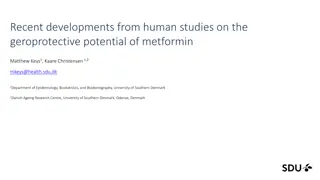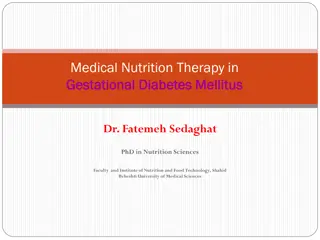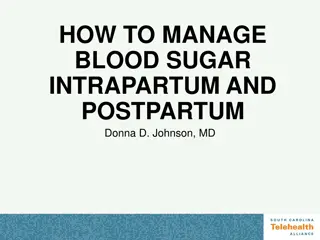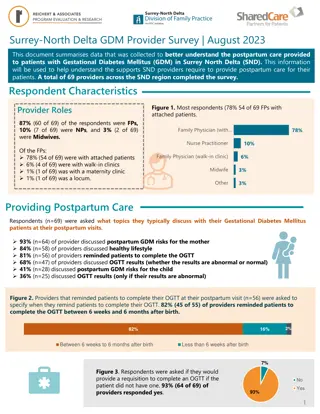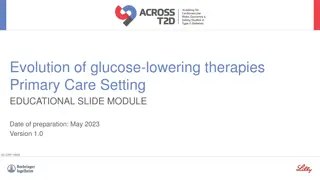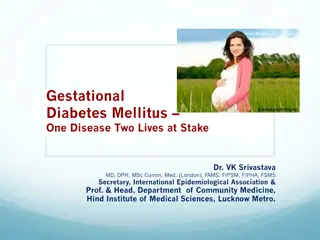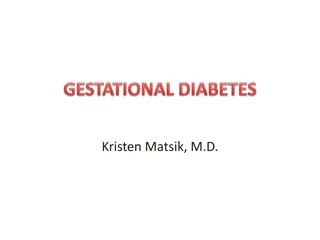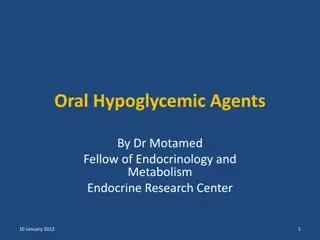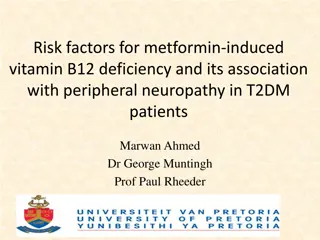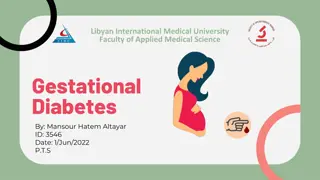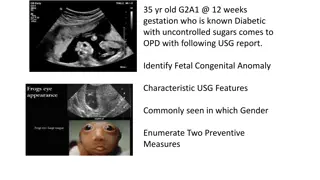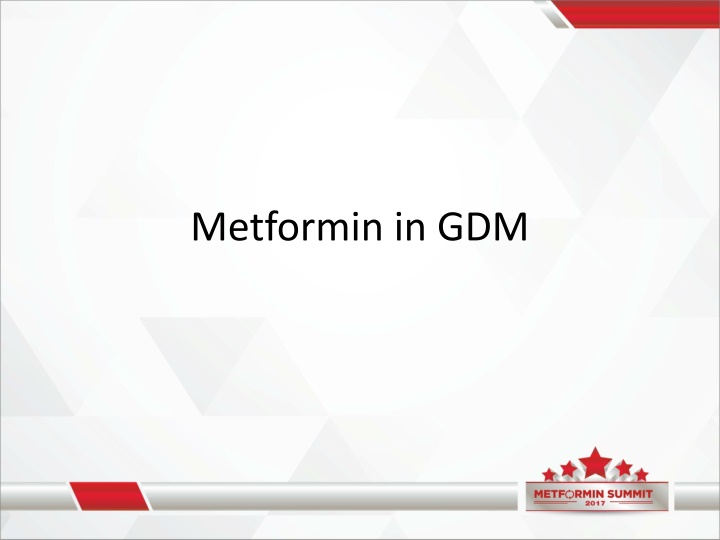
Gestational Diabetes Mellitus (GDM) and Screening Methods
Learn about Gestational Diabetes Mellitus (GDM) and how to screen for diabetes in the first trimester of pregnancy. Explore the diagnosis criteria, cutoff values, and different screening methods recommended by ADA and ACOG guidelines. Find out the significance of insulin sensitivity during different trimesters and the Carpenter/Coustan and ACOG criteria for diagnosing GDM.
Download Presentation

Please find below an Image/Link to download the presentation.
The content on the website is provided AS IS for your information and personal use only. It may not be sold, licensed, or shared on other websites without obtaining consent from the author. If you encounter any issues during the download, it is possible that the publisher has removed the file from their server.
You are allowed to download the files provided on this website for personal or commercial use, subject to the condition that they are used lawfully. All files are the property of their respective owners.
The content on the website is provided AS IS for your information and personal use only. It may not be sold, licensed, or shared on other websites without obtaining consent from the author.
E N D
Presentation Transcript
Case Capsule 26 yrs/F, Referred by gynecologist, 2 months pregnancy, primigravida HbA1c 6.6, OGTT (2 hrs) 165 mg/dl FBS 102
On further evaluation Pre pregnancy BMI 26 kg/m2 Father Type 2 DM No h/o DM before pregnancy No Bad Obstratric History
1. What is the diagnosis ? GDM OR Pre-GDM 2. How to screen for DM in 1sttrimester ? FBS alone OR OGTT (75 gm/100 gm/50 gm)
3. What cut off we need to take ? IADPSG DIPSI ADA ACOG
GDM v/s Pre-GDM Pre-GDM: DM diagnosed in the 1sttrimester GDM: DM diagnosed in 2nd/3rdtrimester ADA 2017 Guidelines
1st trimester: Insulin sensitivity: Increases 2nd/3rd trimester: Insulin sensitivity: Decreases GDM
Screening for DM in 1st trimester Standard criteria for DM as in nonpregnant state FBS + HbA1c/OGTT (75 gm) ADA 2017 Guidelines
Carpenter/Coustan 100 gm OGTT Fasting Based on Risk of DM in future No relation with adverse maternal/fetal outcome in pregnancy Any 2 abnormal values F 95 1 hr 180 2 hr 155 3 hr - 140
ACOG criteria (2 step) 50 gm OGTT Random 100 gm OGTT Fasting 1 hr 140 Any 2 abnormal values F 95 1 hr 180 2 hr 155 3 hr - 140
IADPSG criteria (1 step) 75 gm OGTT Fasting Based on adverse pregnancy outcomes Problem: over-diagnosis of GDM Any 1 abnormal value F 92 1 hr 180 2 hr 153
ADA Guidelines 2017 1 step (IADPSG) Or 2 step (ACOG)
Back to Case She was started on MNT Advised for SMBG at home for 1 week Post prandial > 140 (always)
5. What next ? Metformin ? Insulin ?? Acarabose ?? 6. What are the data for Metformin in GDM ?
7. Metformin v/s Insulin in GDM 8. If any one needs insulin, then which & what regime? 9. How to manage type 2 DM during lactation ?
Supports use of Metformin in GDM IJEM Mar-Apr 2015 / Vol 19 | Issue 2
Several RCTs, meta-analysis and observational studies have largely supported the outcome with metformin. Ease of its use, acceptability by the patients, significantly less maternal weight gain and less maternal hypoglycemia, as evident from these studies, appears a lot encouraging. Moreover, two years follow up of offspring in MIG-TOFU, also reassures no anticipated harm and in fact suggests its beneficial effects in offspring. IJEM Mar-Apr 2015 / Vol 19 | Issue 2
Positive outcomes in pregnant PCOD with metformin use even during the first trimester, almost rules out the remaining ounce of potential harm in terms of any potential teratogenic effect. The emerging clinically equivalent safety and efficacy data of metformin compared to insulin, it appears that it may perhaps open a rather new door in managing GDM. IJEM Mar-Apr 2015 / Vol 19 | Issue 2
Efficacy of Metformin on Pregnancy Complications in PCOS Patients: Forest Plots Metformin therapy throughout pregnancy can reduce the RR of miscarriage and premature birth incidence in PCOS patients with no serious side effects. Gynecol Endocrinol. 2015;31(11):833-9
A meta-analysis of 11 RCTs were performed to compare the effects of metformin with insulin on maternal and neonatal outcomes in GDM. Results : There was no significant difference of the effect on maternal outcomes between the two treatments in HbA1c,FPG, and the incidence of preeclampsia. Whereas, significantly reduced results were found in the metformin group in PIH rate (RR = 0.53), average weight gains after enrollment (MD = -1.28, P\0.0001), and average gestational ages at delivery (MD = 0.94, P = 0.03). Regarding neonatal outcomes, when compared with insulin group, metformin presented significantly lower average birth weights (MD = -44.35 ,P = 0.04), incidence of hypoglycemia (RR = 0.69) and neonatal intensive care unit(NICU) (RR = 0.82). Conclusion : Metformin can significantly reduce several adverse maternal and neonatal outcomes including PIH rate, incidence of hypoglycemia and NICU, thus it may be an effective and safe alternative or additional treatment to insulin for GDM women Arch Gynecol Obstet. 2015 Jul;292(1):111-20.
Could Metformin Manage Gestational Diabetes Mellitus instead of Insulin International Journal of Reproductive Medicine Volume 2016, Article ID 3480629
Precautions to be taken while Prescribing Metformin in GDM Information to the patient that it is not an approved indication. Although metformin is not approved for use in pregnancy, its use as an adjunct therapy in GDM has been considered by several organizations. To be written on the prescription that patient has agreed to take metformin after having explained the same
Insulin Basal Detemir NPH Short acting Regular Lispro Aspart
Target SMBG F 95 1 hr 140 2 hr 120
DM in lactational period Glyburide/Glipizide/Metformin/Insulin: Minimal excretion in breast milk Safe to use Acarbose/DPP4 inhibitors Not yet studied Probably compatible

